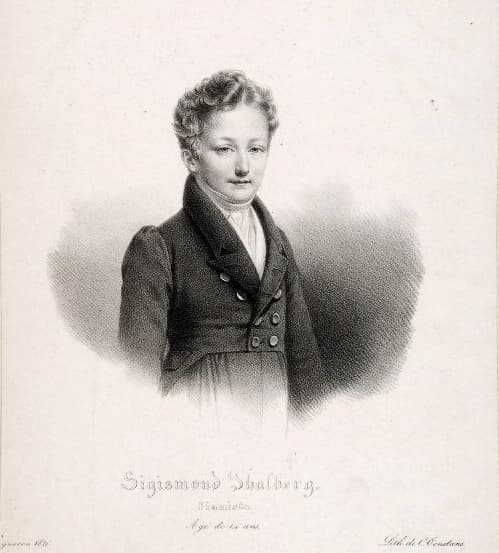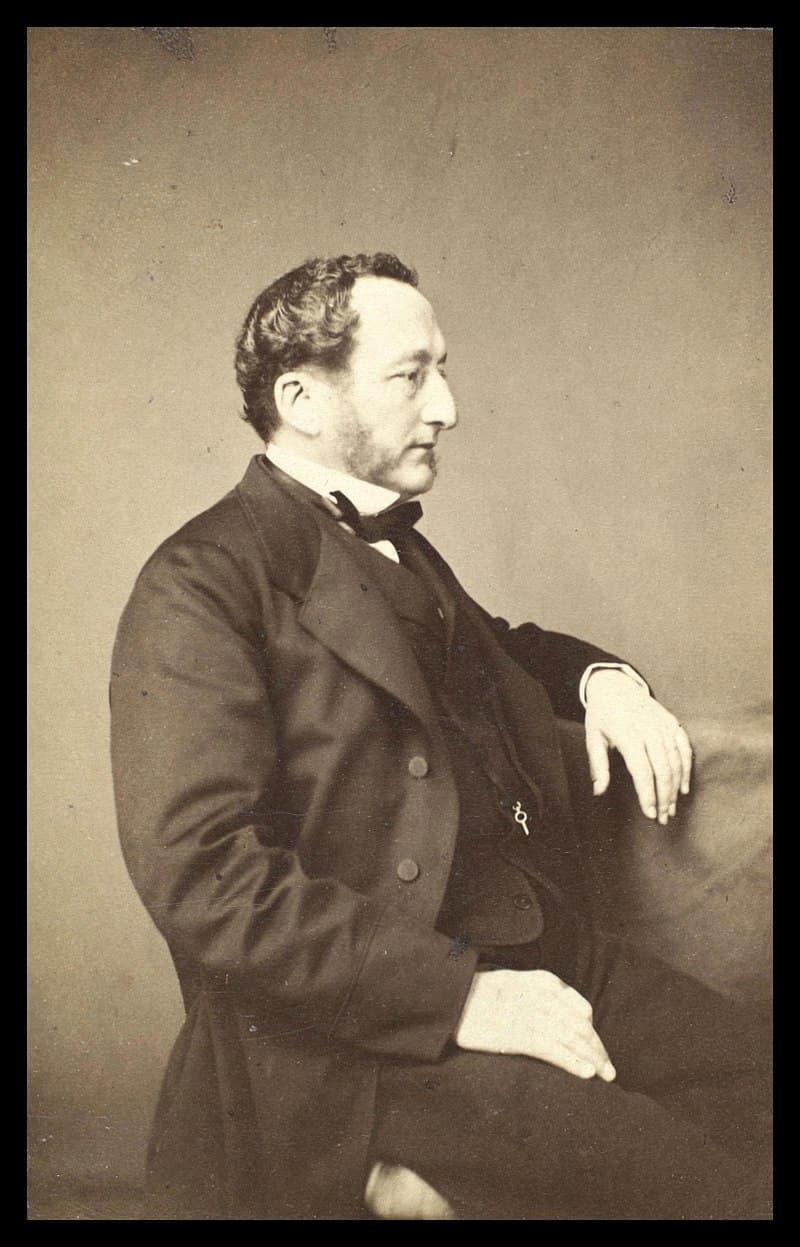In 2024, let’s look at a 24 in music. The Austrian composer and virtuosic pianist Sigismond Thalberg (1812–1871) excelled at a particular 19th-century piano genre that’s largely disappeared, i.e., the operatic paraphrase or fantasy. Thalberg came to Vienna at age 10 from his birthplace in Switzerland, the same year the 10-year-old Franz Liszt arrived in the city. It may have been that he learned piano from his mother, and it wasn’t until he was 14 that he went to London to study with Ignaz Moscheles. Moscheles told Mendelssohn that he thought Thalberg was already good enough for a solo career, so 1826 saw his London debut.

Pierre-Roch Vigneron: Sigismond Thalberg, 1826 (Paris: Bibliothèque nationale)
In 1830, he was in Vienna, where he met Mendelssohn and Chopin, who were in awe of his technical skills. The 10-year-old Clara Schumann, also in Vienna to give concerts and hear them, thought him ‘very accomplished’.
In 1836, Thalberg took Paris by storm, playing his own music and winning the praise of Rossini and Meyerbeer. Chopin took exception to his youth, his playing of octaves, and his diamond shirt studs.

Henry Grevedon: Sigismond Thalberg, 1836 (Gallica, btv1b8425259g)
His career went international, and, in today’s money, probably made $3 million in his last two years on stage. He retired in 1858 to a villa near Naples in Posillipo.
It was at his villa in Posillipo that Thalberg wrote the beautiful Les Soirées de Pausilippe – Hommage à Rossini (Evenings at Posillipo – Homage to Rossini), a set of 24 Pensées musicales (24 Musical Thoughts). They have been compared to an operatic version of Mendelssohn’s Songs Without Words, but unlike many other operatic fantasies, these are filled with an elegant simplicity – the piano is allowed to sing. The voice of the piano was explicated in Thalberg’s earlier didactic work L’art du chant appliqué au piano (The Art of Singing as applied to the Piano), in which he makes use of operatic arias as a means of piano instruction.

Henry Hering: Sigismond Thalberg, ca. 1860 (London: Victoria and Albert Museum)
The 24 pieces of the collection are grouped in complementary pairs, as, for example in the opening, the A flat Andantino leads to a Mendelssohnian E natural movement. The piano sings.
Sigismond Thalberg: Les Soirées de Pausilippe, Hommage à Rossini – 24 Pensées Musicales, Op. 75 – No. 1. Andantino in A-Flat Major (Francesco Nicolosi, piano)
Sigismond Thalberg: Les Soirées de Pausilippe, Hommage à Rossini: 24 Pensées Musicales, Op. 75 – No. 2. Moderato in E Major (Francesco Nicolosi, piano)
From his house in Posillipo, Thalberg would do the occasional Naples concert and receive students (although he couldn’t teach at the Naples Conservatory since he wasn’t Italian). He also created his own vineyard, and his bottles won prizes at the 1967 Paris International Exhibition.
He also included Italian-style music in his collection, such as the tarantella of No. 5.
Sigismond Thalberg: Les Soirées de Pausilippe, Hommage à Rossini: 24 Pensées Musicales, Op. 75 – No. 5. Tempo di Tarantella in G Minor (Francesco Nicolosi, piano)
The fast middle movements, such as in Nos. 15 and 16 offer great contrasts to the slower outside movements.
Sigismond Thalberg: Les Soirées de Pausilippe, Hommage à Rossini: 24 Pensées Musicales, Op. 75 – No. 15. Presto agitato in G Minor (Francesco Nicolosi, piano)
Sigismond Thalberg: Les Soirées de Pausilippe, Hommage à Rossini: 24 Pensées Musicales, Op. 75 – No. 16. Allegro vivace in D-Flat Major (Francesco Nicolosi, piano)
In an 1861 advertisement for the first 12 works in the cycle, the publisher, Heugel et Cie, added an explanation of what these pieces were:
NB Ces Pensées musicales bien qu’écrites spécialement pour le piano, sont surtout remarquables par l’élévation de l’idée mélodique et la distinction des harmonies. En transcrivant à Naples ce que THALBERG appelle ses Soirées de Pausilippe et en les playant sous les auspices du maestro ROSSINI, le virtuose a compris qu’il devait faire place au musicien. Les Pensées musicales de S. Thalberg ne sont donc pas des morceaux d’exécution proprement dite, mais bien plutôt d’intéressantes esquisses de belle et bonne musique de chambre destinées à faire suite à son Art du chant. Les artistes et les élèves trouveront lâ un sujet d’étude et de méditation qui marquera un nouveau progrès dans l’art du Piano.
NB These Musical Thoughts, although written especially for the piano, are especially remarkable for the elevation of the melodic idea and the distinction of the harmonies. By transcribing in Naples what THALBERG calls his Soirées de Pausilippe and playing them under the auspices of maestro ROSSINI, the virtuoso understood that he had to make room for the musician. The Musical Thoughts of S. Thalberg are therefore not pieces of performance strictly speaking, but rather interesting sketches of beautiful and good chamber music intended to follow his Art of Singing. Artists and students will find there a subject of study and meditation which will mark new progress in the art of the Piano.
He closes the collection with one of the popular dances of the time, a polacca, which wasn’t only found in the music of Chopin.
Sigismond Thalberg: Les Soirées de Pausilippe, Hommage à Rossini: 24 Pensées Musicales, Op. 75 – No. 24. Tempo di Polacca in A-Flat Major (Francesco Nicolosi, piano)
They’re fun little pieces where Thalberg is showing off both his love for Rossini and his virtuosic abilities and creating music where the singing tone of the piano comes through.
For more of the best in classical music, sign up for our E-Newsletter
